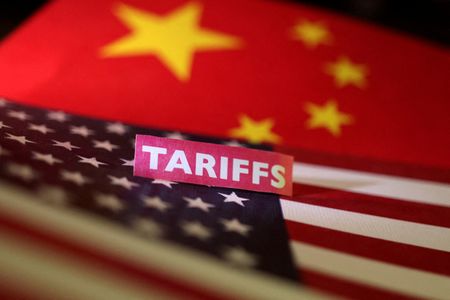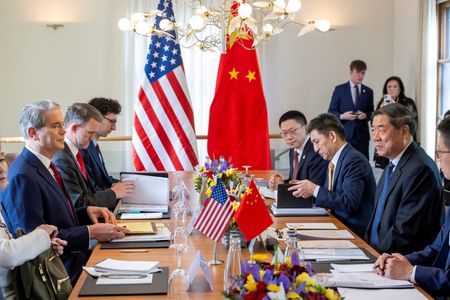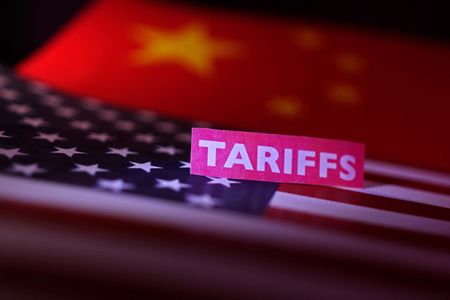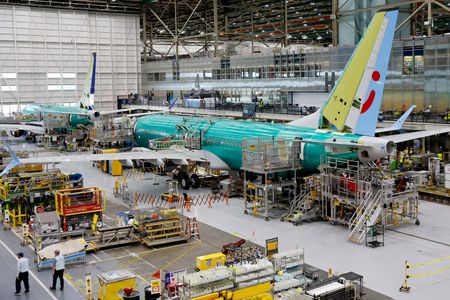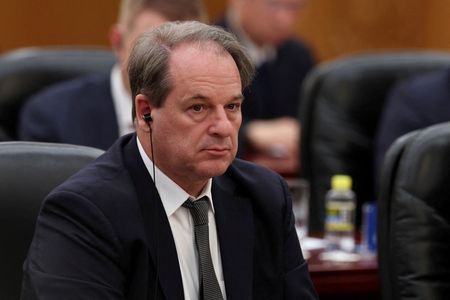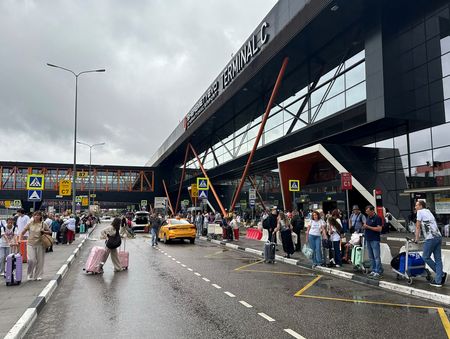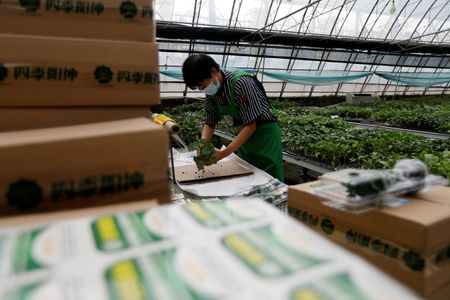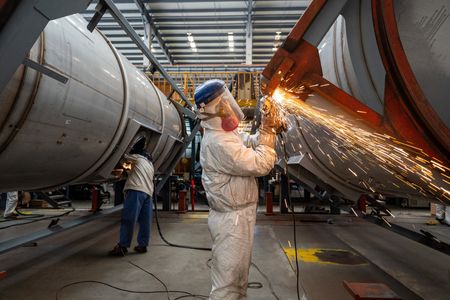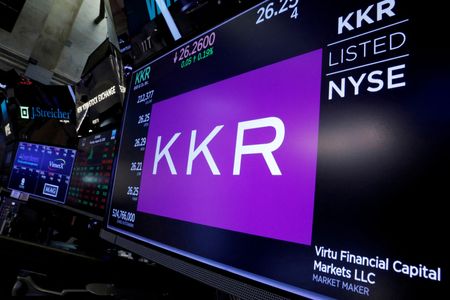By David Lawder
STOCKHOLM (Reuters) -Senior U.S. and Chinese negotiators meet in Stockholm on Monday to tackle longstanding economic disputes at the centre of a trade war between the world’s top two economies, aiming to extend a truce keeping sharply higher tariffs at bay.
China is facing an August 12 deadline to reach a durable tariff agreement with President Donald Trump’s administration, after Beijing and Washington reached a preliminary deal in June to end weeks of escalating tit-for-tat tariffs.
Without an agreement, global supply chains could face renewed turmoil from duties exceeding 100%.
The Stockholm talks, led by U.S. Treasury Secretary Scott Bessent and Chinese Vice Premier He Lifeng, come right on the heels of Trump’s biggest trade deal yet, with the European Union accepting a 15% tariff on its goods exports to the U.S. and agreeing to make significant EU purchases of U.S. energy and military equipment.
That deal struck with European Commission President Ursula von der Leyen on Sunday in Scotland also calls for $600 billion in investments in the U.S. by the EU, Trump told reporters.
No similar breakthrough is expected in the U.S.-China talks, but trade analysts said that another 90-day extension of a tariff and export control truce struck in mid-May was likely.
An extension of that length would prevent further escalation and help create conditions for a potential meeting between Trump and Chinese President Xi Jinping in late October or early November.
Spokespersons for the White House and U.S. Trade Representative’s office did not immediately respond to requests for comment on a South China Morning Post report quoting unnamed sources as saying the two sides would refrain from introducing new tariffs or take other steps that could escalate the trade war for another 90 days.
Trump’s administration is poised to impose new sectoral tariffs that will impact China, including on semiconductors, pharmaceuticals, ship-to-shore cranes and other products.
“We’re very close to a deal with China. We really sort of made a deal with China, but we’ll see how that goes,” Trump told reporters before his meeting with von der Leyen, providing no further details.
DEEPER ISSUES
Previous U.S.-China trade talks in Geneva and London in May and June focused on bringing U.S. and Chinese retaliatory tariffs down from triple-digit levels and restoring the flow of rare earth minerals halted by China and Nvidia’s H20 AI chips and other goods halted by the United States.
So far, the talks have not delved into broader economic issues. They include U.S. complaints that China’s state-led, export-driven model is flooding world markets with cheap goods, and Beijing’s complaints that U.S. national security export controls on tech goods seek to stunt Chinese growth.
“Stockholm will be the first meaningful round of U.S.-China trade talks,” said Bo Zhengyuan, Shanghai-based partner at China consultancy firm Plenum.
Trump has been successful in pressuring some other trading partners, including Japan, Vietnam and the Philippines, into deals accepting higher U.S. tariffs of 15% to 20%.
Analysts say the U.S.-China negotiations are far more complex and will require more time. China’s grip on the global market for rare earth minerals and magnets, used in everything from military hardware to car windshield wiper motors, has proved to be an effective leverage point on U.S. industries.
TRUMP-XI MEETING?
In the background of the talks is speculation about a possible meeting between Trump and Xi in late October.
Trump has said he will decide soon whether to visit China in a landmark trip to address trade and security tensions. A new flare-up of tariffs and export controls would likely derail any plans for a meeting with Xi.
“The Stockholm meeting is an opportunity to start laying the groundwork for a Trump visit to China,” said Wendy Cutler, vice president at the Asia Society Policy Institute.
Bessent has already said he wants to work out an extension of the August 12 deadline to prevent tariffs snapping back to 145% on the U.S. side and 125% on the Chinese side.
Still, China will likely request a reduction of multi-layered U.S. tariffs totaling 55% on most goods and further easing of U.S. high-tech export controls, analysts said. Beijing has argued that such purchases would help reduce the U.S. trade deficit with China, which reached $295.5 billion in 2024.
China is currently facing a 20% tariff related to the U.S. fentanyl crisis, a 10% reciprocal tariff, and 25% duties on most industrial goods imposed during Trump’s first term.
Bessent has also said he would discuss with He the need for China to rebalance its economy away from exports toward domestic consumer demand. The shift would require China to put an end to a protracted property crisis and boost social safety nets to encourage household spending.
Michael Froman, a former U.S. trade representative during Barack Obama’s administration, said such a shift has been a goal of U.S. policymakers for two decades.
“Can we effectively use tariffs to get China to fundamentally change their economic strategy? That remains to be seen,” said Froman, now president of the Council on Foreign Relations think tank.
(Reporting by David Lawder; Additional reporting by Laurie Chen in Beijing;Editing by Helen Popper and Marguerita Choy)

